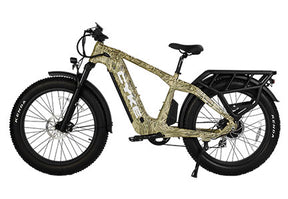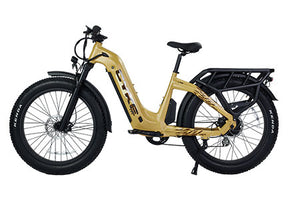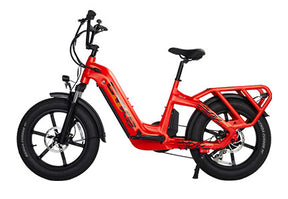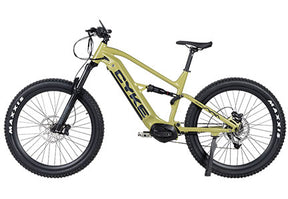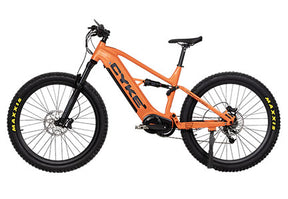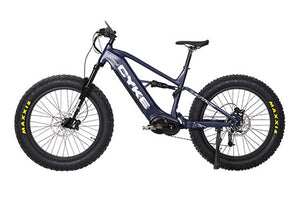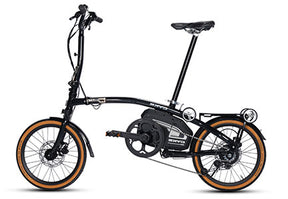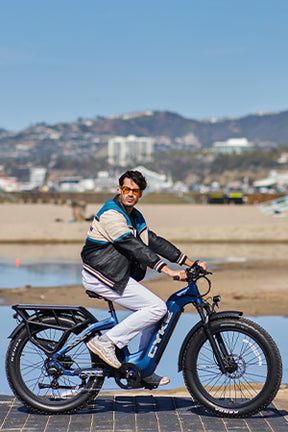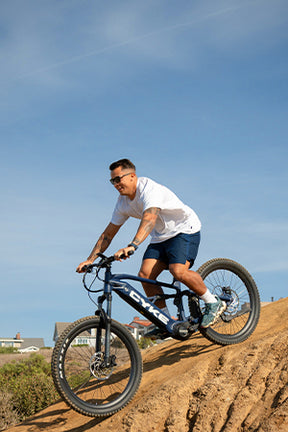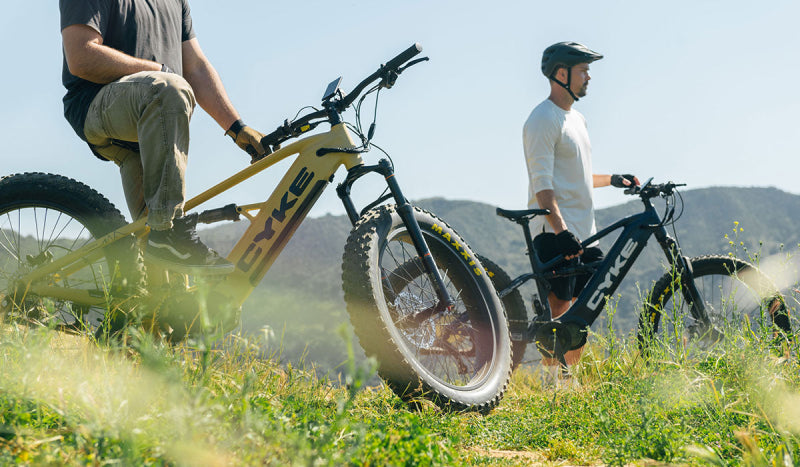Featured in this posts
26" vs 27.5" vs 29" MTB Wheels: How to Choose
Picking the right mountain bike wheels can feel like a big decision. After all, the size of your wheels can change how your bike rides, handles, and how much fun you have on the trail.
Whether you're new to mountain biking or have been riding for years, understanding wheel sizes is key to getting the most out of your bike.
We have discussed eMTB tires in our guide to the best eMTB tires, which you can check out here to get a detailed idea. But now let's focus on wheel sizes.
You’ve probably seen terms like 26", 27.5", and 29". Each size has its own strengths, and selecting the right one depends on how you ride and the terrain you like to explore.
Let’s break down the key differences between 26", 27.5", and 29" MTB wheels, to help you make an informed decision to optimize your rides, enhance your skills, and enjoy your time on the trails.
Understanding MTB Wheel Sizes
When people talk about 26", 27.5", or 29" MTB wheels, they’re referring to the diameter of the wheel including the tire, not just the rim. This wheel size impacts how your bike handles, rides, and feels across different types of terrain.
Let’s break down these wheel sizes to understand how each one performs and why you might choose one over another.
What are 26 Inch MTB Wheels?
The 26 inch bike tires are a classic. It’s the original size for mountain bikes and is loved for its quick and nimble handling. The wheel diameter (with the tire) measures around 673 mm, while the rim diameter is 559 mm.
These wheels are small and lightweight. Their agility helps you react quickly, which is perfect for riders who value precision and control. While they’re less common on newer bikes, some riders still prefer 26 inch wheel bike for their maneuverability and responsiveness.
What are 27.5 Inch MTB Wheels?
Often referred to as the "Goldilocks" of MTB wheel sizes, because these 27.5 mountain bike wheels sit between the smaller 26" and larger 29" wheels. With a wheel diameter of about 698 mm and a rim diameter of 584 mm, these wheels strike a nice balance between agility and stability.
They aren’t as twitchy as 26" wheels, but still feel more agile than the larger 29" size. If you ride a mix of trail types, these 27.5 bike tires can provide a smooth and versatile experience.
What are 29 Inch MTB Wheels?
These are the largest of the three. Their full diameter with a tire measures about 736 mm, and the rim diameter is 622 mm.
They’re stable and fast, making them perfect for rough, rugged trails and long-distance rides. Riders who want momentum and a smoother ride over uneven terrain often lean toward 29 inch mountain bike tires.
26" vs 27.5" vs 29" MTB Wheels
Here’s a closer look at the pros and cons of each wheel size to help you decide:
26 Inch MTB Wheels: Pros and Cons
Pros:
- Extremely agile, perfect for tight trails and quick turns.
- Lightweight, so they’re easy to accelerate.
- Lower center of gravity for better control.
- Fits riders of all sizes well.
- Quick off-the-line acceleration, ideal for technical or urban riding.
Cons:
- Struggles with bigger obstacles due to the smaller size.
- Less stable at high speeds.
- Needs more suspension to handle bumps, which can reduce efficiency.
- Requires higher tire pressure, which can feel less forgiving on rough terrain.
27.5 Inch MTB Wheels: Pros and Cons
Pros:
- Combines agility and stability, offering the best of both worlds.
- Faster top speed than 26" wheels but is more responsive than 29ers.
- Smooth ride on technical and cross-country trails.
- A good option for smaller riders who want larger wheels without compromising fit.
- Comfortable and natural riding position.
- Works well across different trail conditions.
Cons:
- Heavier than 26" wheels.
- Doesn’t roll over obstacles as easily as 29ers.
- Slightly less stable on steep downhill sections.
29 Inch MTB Wheels: Pros and Cons
Pros:
- Superior ability to roll over rocks, roots, and rough terrain.
- Provides excellent traction and stability on high-speed rides.
- Great for making it easier to cross gullies when riding off-road.
- Better suited for long-distance rides, rugged trails, and taller rides.
- Requires less suspension travel, improving pedaling efficiency.
Cons:
- Heavier, requiring more effort to accelerate.
- Harder to maneuver on tight, technical trails.
- Can feel too big or bulky for shorter riders.
Choosing the Best MTB Wheel Size for eMTBs
When it comes to eMTBs, wheel size becomes even more critical due to the added speed and weight of the bike. Here’s a look at three excellent options tailored to specific riding styles.
Falcon A: Perfect for Trail Riders
The Falcon A is made for those who love the trails. It has 27.5x3.0" tires, which strike a nice balance between agility and stability. These tires grip well and offer a smooth ride, especially on technical trails.
This eMTB features a soft-tail design and a RockShox four-bar suspension system, which absorbs bumps and makes off-road trips smoother and more comfortable. The wider tires give you better traction and stability, so it’s a solid choice for riders who want versatility and comfort on different trails.
Falcon S: Optimal for Speed and Stability
For riders prioritizing speed and stability, the Falcon S is a fantastic option. With its 29x3.0" tires, it rolls over obstacles effortlessly and keeps its grip on rugged terrain. These wheels keep their momentum, which makes long rides feel less tiring.
Powered by a BAFANG Mid-Drive motor that delivers up to 1000W and 160 Nm of torque, the 29 inch mountain bike feels strong and capable, even on long, tough trails. If you like to move fast while staying steady, the Falcon S is your match.
Falcon X: Built for Extreme Terrain
If conquering extreme terrain is your goal, the Falcon X is the perfect companion. It has big MAXXIS 26x4.8" snow tires designed to handle sand, snow, mud, and anything else nature throws your way. These wide tires grip the ground like nothing else, giving you control even on slippery surfaces.
This bike also has a torque sensor for precise, smooth acceleration. It feels natural, even on tricky climbs. Built for extreme terrain, the Falcon X is the eMTB you want if your rides take you to the most challenging places.
Common FAQs About MTB Wheel Sizes
Do Larger MTB Wheels Make Riding Easier?
Yes, larger MTB wheels like 27.5" and 29" make riding easier in certain scenarios, rolling over obstacles with greater ease, and providing a smoother ride. Larger wheels also offer better traction and stability, which can be helpful for beginners or riders tackling rugged trails.
Are 26 Inch MTB Wheels Still Relevant in Modern Riding?
Yes, 26" wheels are still relevant for riders who value agility and quick handling. They’re ideal for technical trails, urban environments, and riders who prefer a lighter setup.
Which MTB Wheel Size Should I Choose?
The best wheel size depends on your riding style, terrain, and preferences:
- Choose 26" if you prioritize agility and ride tight, technical trails.
- Opt for 27.5" for a balanced ride that performs well on most terrains.
- Go for 29" if you value speed, stability, long rides, and rolling efficiency on rugged trails.
Conclusion
Choosing the right size MTB wheels depends on what kind of rider you are. If you’re into versatile trails, go for the Falcon A. For high-speed adventures, the Falcon S is a great fit. And if your goal is conquering extreme terrain, the Falcon X is the way to go.
Whether you prefer nimble handling, a balanced ride, or superior rolling capabilities, there’s a wheel size out there that’s perfect for you. Take the time to explore your options and make an informed choice to elevate your mountain biking experience.
